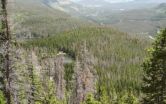(Press-News.org) A geostatistical approach for studying environmental conditions in stream networks and landscapes has been successfully applied at a valley-wide scale to assess headwater stream chemistry at high resolution, revealing unexpected patterns in natural chemical components.
"Headwater streams make up the majority of stream and river length in watersheds, affecting regional water quality," said Assistant Professor Kevin J. McGuire, associate director of the Virginia Water Resources Research Center in Virginia Tech's College of Natural Resources and Environment. "However, the actual patterns and causes of variation of water quality in headwater streams are often unknown."
"Understanding the chemistry of these streams at a finer scale could help to identify factors impairing water quality and help us protect aquatic ecosystems," said Gene E. Likens, president emeritus and distinguished senior scientist emeritus with the Cary Institute of Ecosystem Studies and the University of Connecticut.
Results of the study that used a new statistical tool to describe spatial patterns of water chemistry in stream networks are published in the April 21 issue of the Proceedings of the National Academies of Science by a team of ecosystem scientists, including McGuire and Likens.
The data used in the new analysis consist of 664 water samples collected every 300 feet throughout all 32 tributaries of the 14-square-mile Hubbard Brook Valley in New Hampshire. The chemistry results were originally reported in 2006 in the journal Biogeochemistry by Likens and Donald C. Buso, manager of field research with the Cary Institute.
McGuire and other members of the National Science Foundation's Long-Term Ecological Research team at the Hubbard Brook Ecosystem Study decided that the huge, high-resolution dataset was ideal for a new statistical approach that examines how water flows both within the stream network and across the landscape.
"The goal was to visualize patterns that no one has been able to quantify before now and describe how they vary within headwater stream networks," said McGuire. "Some chemical constituents vary at a fine scale, that is patterns of chemical change occur over very short distances, for example several hundred feet, but some constituents vary over much larger scales, for example miles. Several chemical constituents that we examined even varied at multiple scales suggesting that nested processes within streams and across the landscape influence the chemistry of stream networks."
"The different spatial relationships permit the examination of patterns controlled by landscape versus stream network processes," the article reports. Straight-line and unconnected network spatial relationships indicate landscape influences, such as soil, geology, and vegetation controls of water chemistry, for instance. In contrast, flow-connected relationships provide information on processes affected within the flowing streams.
The researchers are very familiar with the Hubbard Brook Valley and could point to the varying influences of the geology and distinct soil types, including areas of shallow acidic organic-rich soils.
The findings revealed by the analysis technique showed how chemistry patterns vary across landscapes with two scales of variation, one around 1,500 feet and another at about 4 miles. However, when chemistry patterns were examined only in the downstream direction, there was predominantly one scale of variation, which was less than about 1 mile.
The journal article concludes, "This spatially explicit, network-level analysis is crucial to refining long-held assumptions and stream structure and function."
"One assumption that is typical in streams is that the chemical variation is controlled primarily by the way in which water flows in streams, which would cause gradients or patterns that are strongly oriented downstream," said McGuire.
"Of course we found that to be the case; however, we were able to show that patterns affected different dissolved chemical elements at different scales, or distances, along the stream network," he continued. "In addition to downstream gradients, we show that there were also 'patches' of variation in the patterns of dissolved chemicals that were caused by processes related to the watershed or landscape.
"In other words, natural chemical variation is not just influenced by the flow accumulation in rivers but processes operating within the landscape or watershed that affect the gradual downstream variation in chemistry, which is probably intuitive to most, but has never been quantified at both the fine scale and broad valley-wide extent as examined this study," McGuire said.
"It really highlights the complexity of spatial patterns in stream networks, particularly in these small headwater streams that aggregate to create larger rivers that we all depend on for ecosystem services," he said. "Understanding the natural variation of water chemistry in these headwater regions may help watershed managers choose better monitoring sites or at least be able to better interpret monitoring data and more efficiently track changes in water quality as land use and climate conditions change."
INFORMATION:
Co-authors on the article are McGuire; Christian E. Torgersen of the U.S. Geological Survey, Forest and Rangeland Ecosystem Science Center, Cascadia Field Station in Seattle; Likens; Buso; Winsor H. Lowe of the Division of Biological Sciences at the University of Montana; and Scott W. Bailey of the U.S. Forest Service, Northern Research Station. McGuire and Likens are the corresponding authors.
Financial support for data collection was provided by the National Science Foundation and the A.W. Mellon Foundation. Hubbard Brook is part of the White Mountain National Forest in New Hampshire and operated by the Northern Research Station of the U.S. Forest Service.
Written by Susan Trulove.
Ecology team improves understanding of valley-wide stream chemistry
Analysis reveals unexpected patterns in chemical components
2014-04-21
ELSE PRESS RELEASES FROM THIS DATE:
A plague in your family
2014-04-21
For the first time, researchers have studied the Black Death bacterium's entire family tree to fully understand how some of the family members evolve to become harmful.
Contrary to popular belief, the team found pathogenic members of this bacterial family do not share a recent common disease-causing ancestor, but instead, have followed parallel evolutionary paths to become harmful.
The Yersinia family of bacteria has many sub species, some of which are harmful and others not. Two of the most feared members of this bacterial family are Yersinia pestis, the bacterium ...
Malfunction in molecular 'proofreader' prevents repair of UV-induced DNA damage
2014-04-21
PITTSBURGH, April 21, 2014 – Malfunctions in the molecular "proofreading" machinery, which repairs structural errors in DNA caused by ultraviolet (UV) light damage, help explain why people who have the disease xeroderma pigmentosum (XP) are at an extremely high risk for developing skin cancer, according to researchers at the University of Pittsburgh School of Medicine and the University of Pittsburgh Cancer Institute (UPCI). Their findings will be published this week in the early online version of the Proceedings of the National Academy of Sciences.
Previous research ...
Penn Medicine researchers uncover hints of a novel mechanism behind general anesthetic action
2014-04-21
(PHILADELPHIA) – Despite decades of common use for surgeries of all kinds, the precise mechanism through which general anesthesia works on the body remains a mystery. This may come as a surprise to the millions of Americans who receive inhaled general anesthesia each year. New research led by the Perelman School of Medicine at the University of Pennsylvania investigated the common anesthetic sevoflurane and found that it binds at multiple key cell membrane protein locations that may contribute to the induction of the anesthetic response. Their findings will appear online ...
Earth Week: Bark beetles change Rocky Mountain stream flows, affect water quality
2014-04-21
On Earth Week--and in fact, every week now--trees in mountains across the western United States are dying, thanks to an infestation of bark beetles that reproduce in the trees' inner bark.
Some species of the beetles, such as the mountain pine beetle, attack and kill live trees. Others live in dead, weakened or dying hosts.
In Colorado alone, the mountain pine beetle has caused the deaths of more than 3.4 million acres of pine trees.
What effect do all these dead trees have on stream flow and water quality? Plenty, according to new research findings reported this ...
Krypton-dating technique allows researchers to accurately date ancient Antarctic ice
2014-04-21
A team of scientists, funded by the National Science Foundation (NSF), has successfully used a new technique to confirm the age of a 120,000-year-old sample of Antarctic ice.
The new dating system is expected to allow scientists to identify ice that is much older, thereby reconstructing climate much farther back into Earth's history and potentially leading to an understanding of the mechanisms that cause the planet to shift into and out of ice ages.
The use of a radiometric-Krypton-dating technique on ice from Antarctica's Taylor Glacier was documented in a paper published ...
Progress made in developing nanoscale electronics
2014-04-21
Scientists are facing a number of barriers as they try to develop circuits that are microscopic in size, including how to reliably control the current that flows through a circuit that is the width of a single molecule.
Alexander Shestopalov, an assistant professor of chemical engineering at the University of Rochester, has done just that, thereby taking us one step closer to nanoscale circuitry.
"Until now, scientists have been unable to reliably direct a charge from one molecule to another," said Shestopalov. "But that's exactly what we need to do when working with ...
A gene within a gene contributes to the aggressiveness of acute myeloid leukemia
2014-04-21
COLUMBUS, Ohio – A small gene that is embedded in a larger, well-known gene is the true leukemia-promoting force usually attributed to the larger gene, according to a new study by researchers at The Ohio State University Comprehensive Cancer Center – Arthur G. James Cancer Hospital and Richard J. Solove Research Institute (OSUCCC – James).
The findings are published in the journal Science Signaling.
The larger host gene is called BAALC (pronounced "Ball C"). The smaller embedded gene is called microRNA-3151 (miR-3151). The study investigated the degree to which each ...
Simulating in tiny steps gave birth to long-sought-after method
2014-04-21
Using computer simulations to predict which drug candidates offer the greatest potential has thus far not been very reliable, because both small drug-like molecules and the amino acids of proteins vary so much in their chemistry. Uppsala researchers have now cunningly managed to develop a method that has proven to be precise, reliable and general.
The largest class of human target proteins for drugs are the so-called G-protein-coupled receptors. They are targets for about 40 per cent of all drugs on the market. These receptors are found in the cell membrane and handle ...
Lack of breeding threatens blue-footed boobies' survival
2014-04-21
Blue-footed Boobies are on the decline in the Galápagos.
A new study appearing in the journal Avian Conservation and Ecology indicates numbers of the iconic birds, known for their bright blue feet and propensity to burst into dance to attract mates, have fallen more than 50 percent in less than 20 years.
The drastic drop in population is probably due to an unexplained disappearance of sardines from the Boobies' diet, said Dave Anderson, a professor of biology at Wake Forest University and the study's principal investigator. This in turn has adult Boobies electing not ...
NASA sees wind shear affecting newborn Tropical Cyclone Jack
2014-04-21
Tropical Cyclone Jack may have hurricane-force winds today, April 21, but strong vertical wind shear is expected to weaken the storm. NASA's TRMM satellite passed overhead and saw that the bulk of the storm's rainfall was being pushed south of the center from the wind shear.
Tropical Cyclone Jack formed on Sunday, April 20, near 13.4 south and 91.1 east, and began moving to the south at 6 knots/6.9 mph/11.1 kph. Jack strengthened quickly and hours after its birth, the storm already had maximum sustained winds near 55 knots/63.2 mph/101.9 kph.
On April 21 at 0900 UTC/5 ...
LAST 30 PRESS RELEASES:
Anthropologists offer new evidence of bipedalism in long-debated fossil discovery
Safer receipt paper from wood
Dosage-sensitive genes suggest no whole-genome duplications in ancestral angiosperm
First ancient human herpesvirus genomes document their deep history with humans
Why Some Bacteria Survive Antibiotics and How to Stop Them - New study reveals that bacteria can survive antibiotic treatment through two fundamentally different “shutdown modes”
UCLA study links scar healing to dangerous placenta condition
CHANGE-seq-BE finds off-target changes in the genome from base editors
The Journal of Nuclear Medicine Ahead-of-Print Tip Sheet: January 2, 2026
Delayed or absent first dose of measles, mumps, and rubella vaccination
Trends in US preterm birth rates by household income and race and ethnicity
Study identifies potential biomarker linked to progression and brain inflammation in multiple sclerosis
Many mothers in Norway do not show up for postnatal check-ups
Researchers want to find out why quick clay is so unstable
Superradiant spins show teamwork at the quantum scale
Cleveland Clinic Research links tumor bacteria to immunotherapy resistance in head and neck cancer
First Editorial of 2026: Resisting AI slop
Joint ground- and space-based observations reveal Saturn-mass rogue planet
Inheritable genetic variant offers protection against blood cancer risk and progression
Pigs settled Pacific islands alongside early human voyagers
A Coral reef’s daily pulse reshapes microbes in surrounding waters
EAST Tokamak experiments exceed plasma density limit, offering new approach to fusion ignition
Groundbreaking discovery reveals Africa’s oldest cremation pyre and complex ritual practices
First breathing ‘lung-on-chip’ developed using genetically identical cells
How people moved pigs across the Pacific
Interaction of climate change and human activity and its impact on plant diversity in Qinghai-Tibet plateau
From addressing uncertainty to national strategy: an interpretation of Professor Lim Siong Guan’s views
Clinical trials on AI language model use in digestive healthcare
Scientists improve robotic visual–inertial trajectory localization accuracy using cross-modal interaction and selection techniques
Correlation between cancer cachexia and immune-related adverse events in HCC
Human adipose tissue: a new source for functional organoids
[Press-News.org] Ecology team improves understanding of valley-wide stream chemistryAnalysis reveals unexpected patterns in chemical components




